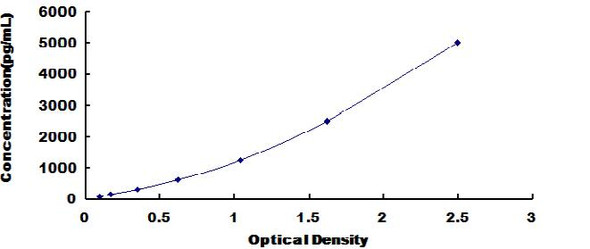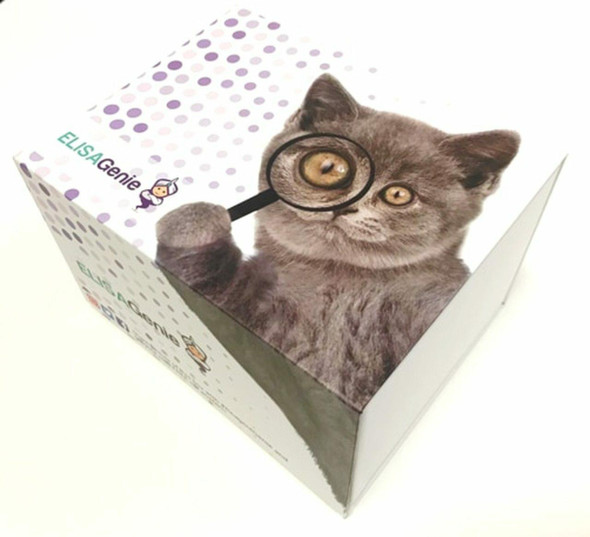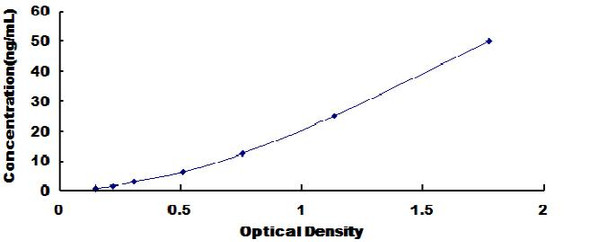Human Pyruvate kinase isozymes M1/M2 (PKM2) ELISA Kit (HUEB0752)
- SKU:
- HUEB0752
- Product Type:
- ELISA Kit
- Size:
- 96 Assays
- Uniprot:
- P14618
- Range:
- 1.56-100 U/mL
- ELISA Type:
- Sandwich
- Synonyms:
- PKM2, Pyruvate kinase isozymes M1, M2
- Reactivity:
- Human
Description
Human Pyruvate kinase isozymes M1/M2 (PKM2) ELISA Kit
The Human Pyruvate Kinase Isozymes M1/M2 (PKM2) ELISA Kit is a reliable tool for detecting and quantifying levels of PKM2 in human serum, plasma, and cell culture supernatants. This kit offers high sensitivity and specificity, ensuring accurate and reproducible results for a variety of research purposes.Pyruvate kinase is an enzyme responsible for catalyzing the final step of glycolysis, the breakdown of glucose to produce energy in the form of ATP. The M2 isoform of pyruvate kinase, known as PKM2, plays a critical role in cancer metabolism by promoting aerobic glycolysis and tumor growth.
By measuring PKM2 levels, researchers can gain valuable insights into cancer biology, metabolic disorders, and other diseases where dysregulated PKM2 activity is implicated. The Human Pyruvate Kinase Isozymes M1/M2 (PKM2) ELISA Kit is an essential tool for advancing our understanding of these conditions and exploring potential therapeutic strategies.
| Product Name: | Human Pyruvate kinase isozymes M1/M2 (PKM2) ELISA Kit |
| SKU: | HUEB0752 |
| Size: | 96T |
| Target: | Human Pyruvate kinase isozymes M1/M2 (PKM2) |
| Synonyms: | Cytosolic thyroid hormone-binding protein, Opa-interacting protein 3, Pyruvate kinase 2/3, Pyruvate kinase muscle isozyme, Thyroid hormone-binding protein 1, Tumor M2-PK, p58, CTHBP, OIP-3, THBP1, OIP3, PK2, PK3, PKM2 |
| Assay Type: | Sandwich |
| Detection Method: | ELISA |
| Reactivity: | Human |
| Detection Range: | 1.56-100U/mL |
| Sensitivity: | 0.98U/mL |
| Intra CV: | 3.9% | ||||||||||||||||||||
| Inter CV: | 7.7% | ||||||||||||||||||||
| Linearity: |
| ||||||||||||||||||||
| Recovery: |
| ||||||||||||||||||||
| Function: | Glycolytic enzyme that catalyzes the transfer of a phosphoryl group from phosphoenolpyruvate (PEP) to ADP, generating ATP. Stimulates POU5F1-mediated transcriptional activation. Plays a general role in caspase independent cell death of tumor cells. The ratio between the highly active tetrameric form and nearly inactive dimeric form determines whether glucose carbons are channeled to biosynthetic processes or used for glycolytic ATP production. The transition between the 2 forms contributes to the control of glycolysis and is important for tumor cell proliferation and survival. |
| Uniprot: | P14618 |
| Sample Type: | Serum, plasma, tissue homogenates, cell culture supernates and other biological fluids |
| Specificity: | Natural and recombinant human Pyruvate kinase PKM |
| Sub Unit: | Monomer and homotetramer. Exists as a monomer in the absence of D-fructose 1,6-bisphosphate (FBP), and reversibly associates to form a homotetramer in the presence of FBP. The monomeric form binds T3. Tetramer formation induces pyruvate kinase activity. The tetrameric form has high affinity for the substrate and is associated within the glycolytic enzyme complex. Exists in a nearly inactive dimeric form in tumor cells and the dimeric form has less affinity for the substrate. Binding to certain oncoproteins such as HPV-16 E7 oncoprotein can trigger dimerization. FBP stimulates the formation of tetramers from dimers. Interacts with HERC1, POU5F1 and PML. Interacts (isoform M2) with EGLN3; the interaction hydroxylates PKM under hypoxia and enhances binding to HIF1A. Interacts (isoform M2) with HIF1A; the interaction is enhanced by binding of EGLN3, promoting enhanced transcription activity under hypoxia. Interacts (isoform M2, but not isoform M1) with TRIM35; this interaction prevents FGFR1-dependent tyrosine phosphorylation (PubMed:25263439). |
| Research Area: | Epigenetics |
| Subcellular Location: | Cytoplasm Nucleus Translocates to the nucleus in response to different apoptotic stimuli. Nuclear translocation is sufficient to induce cell death that is caspase independent, isoform-specific and independent of its enzymatic activity. |
| Storage: | Please see kit components below for exact storage details |
| Note: | For research use only |
| UniProt Protein Function: | PKM2: one of three rate-limiting enzymes in glycolysis. It catalyzes the transfer of a phosphate group from phosphoenolpyruvate (PEP) to ADP, yielding one molecule ATP and a pyruvate molecule, which is a central metabolic intermediate that can be used as a building block or oxidized further. Overexpressed in a variety of cancers. Interacts with thyroid hormone, and thus may mediate cellular metabolic effects induced by thyroid hormones. Binds Opa protein, a bacterial outer membrane protein involved in gonococcal adherence to and invasion of human cells, suggesting a role of this protein in bacterial pathogens is. There are several mammalian isozymes of pyruvate kinase encoded by different genes. The L type predominates in liver, and the M type in muscle and brain. Two alternatively spliced human isoforms of PKM2 have been reported. |
| UniProt Protein Details: | Protein type:Carbohydrate Metabolism - glycolysis and gluconeogenesis; Kinase, other; EC 2.7.1.40; Carbohydrate Metabolism - pyruvate; Mitochondrial; Nucleotide Metabolism - purine Chromosomal Location of Human Ortholog: 15q22 Cellular Component: extracellular matrix; mitochondrion; cytoplasm; plasma membrane; nucleus; cytosol; vesicle; cilium Molecular Function:potassium ion binding; protein binding; magnesium ion binding; pyruvate kinase activity; ATP binding Biological Process: glycolysis; carbohydrate metabolic process; programmed cell death; glucose metabolic process; pathogenesis; phosphorylation |
| NCBI Summary: | This gene encodes a protein involved in glycolysis. The encoded protein is a pyruvate kinase that catalyzes the transfer of a phosphoryl group from phosphoenolpyruvate to ADP, generating ATP and pyruvate. This protein has been shown to interact with thyroid hormone and may mediate cellular metabolic effects induced by thyroid hormones. This protein has been found to bind Opa protein, a bacterial outer membrane protein involved in gonococcal adherence to and invasion of human cells, suggesting a role of this protein in bacterial pathogenesis. Several alternatively spliced transcript variants encoding a few distinct isoforms have been reported. [provided by RefSeq, May 2011] |
| UniProt Code: | P14618 |
| NCBI GenInfo Identifier: | 20178296 |
| NCBI Gene ID: | 5315 |
| NCBI Accession: | P14618.4 |
| UniProt Secondary Accession: | P14618,P14786, Q53GK4, Q96E76, Q9BWB5, Q9UCV6, Q9UPF2 A6NFK3, B2R5N8, B3KRY0, B4DFX8, B4DUU6, |
| UniProt Related Accession: | P14618 |
| Molecular Weight: | |
| NCBI Full Name: | Pyruvate kinase PKM |
| NCBI Synonym Full Names: | pyruvate kinase, muscle |
| NCBI Official Symbol: | PKM |
| NCBI Official Synonym Symbols: | PK3; TCB; OIP3; PKM2; CTHBP; THBP1; HEL-S-30 |
| NCBI Protein Information: | pyruvate kinase PKM; p58; OIP-3; tumor M2-PK; PK, muscle type; pyruvate kinase 2/3; OPA-interacting protein 3; pyruvate kinase isozymes M1/M2; pyruvate kinase muscle isozyme; thyroid hormone-binding protein 1; epididymis secretory protein Li 30; cytosolic thyroid hormone-binding protein; thyroid hormone-binding protein, cytosolic |
| UniProt Protein Name: | Pyruvate kinase PKM |
| UniProt Synonym Protein Names: | Cytosolic thyroid hormone-binding protein; CTHBP; Opa-interacting protein 3; OIP-3; Pyruvate kinase 2/3; Pyruvate kinase muscle isozyme; Thyroid hormone-binding protein 1; THBP1; Tumor M2-PK; p58 |
| Protein Family: | Pyruvate kinase |
| UniProt Gene Name: | PKM |
| UniProt Entry Name: | KPYM_HUMAN |
| Component | Quantity (96 Assays) | Storage |
| ELISA Microplate (Dismountable) | 8×12 strips | -20°C |
| Lyophilized Standard | 2 | -20°C |
| Sample Diluent | 20ml | -20°C |
| Assay Diluent A | 10mL | -20°C |
| Assay Diluent B | 10mL | -20°C |
| Detection Reagent A | 120µL | -20°C |
| Detection Reagent B | 120µL | -20°C |
| Wash Buffer | 30mL | 4°C |
| Substrate | 10mL | 4°C |
| Stop Solution | 10mL | 4°C |
| Plate Sealer | 5 | - |
Other materials and equipment required:
- Microplate reader with 450 nm wavelength filter
- Multichannel Pipette, Pipette, microcentrifuge tubes and disposable pipette tips
- Incubator
- Deionized or distilled water
- Absorbent paper
- Buffer resevoir
*Note: The below protocol is a sample protocol. Protocols are specific to each batch/lot. For the correct instructions please follow the protocol included in your kit.
Allow all reagents to reach room temperature (Please do not dissolve the reagents at 37°C directly). All the reagents should be mixed thoroughly by gently swirling before pipetting. Avoid foaming. Keep appropriate numbers of strips for 1 experiment and remove extra strips from microtiter plate. Removed strips should be resealed and stored at -20°C until the kits expiry date. Prepare all reagents, working standards and samples as directed in the previous sections. Please predict the concentration before assaying. If values for these are not within the range of the standard curve, users must determine the optimal sample dilutions for their experiments. We recommend running all samples in duplicate.
| Step | |
| 1. | Add Sample: Add 100µL of Standard, Blank, or Sample per well. The blank well is added with Sample diluent. Solutions are added to the bottom of micro ELISA plate well, avoid inside wall touching and foaming as possible. Mix it gently. Cover the plate with sealer we provided. Incubate for 120 minutes at 37°C. |
| 2. | Remove the liquid from each well, don't wash. Add 100µL of Detection Reagent A working solution to each well. Cover with the Plate sealer. Gently tap the plate to ensure thorough mixing. Incubate for 1 hour at 37°C. Note: if Detection Reagent A appears cloudy warm to room temperature until solution is uniform. |
| 3. | Aspirate each well and wash, repeating the process three times. Wash by filling each well with Wash Buffer (approximately 400µL) (a squirt bottle, multi-channel pipette,manifold dispenser or automated washer are needed). Complete removal of liquid at each step is essential. After the last wash, completely remove remaining Wash Buffer by aspirating or decanting. Invert the plate and pat it against thick clean absorbent paper. |
| 4. | Add 100µL of Detection Reagent B working solution to each well. Cover with the Plate sealer. Incubate for 60 minutes at 37°C. |
| 5. | Repeat the wash process for five times as conducted in step 3. |
| 6. | Add 90µL of Substrate Solution to each well. Cover with a new Plate sealer and incubate for 10-20 minutes at 37°C. Protect the plate from light. The reaction time can be shortened or extended according to the actual color change, but this should not exceed more than 30 minutes. When apparent gradient appears in standard wells, user should terminatethe reaction. |
| 7. | Add 50µL of Stop Solution to each well. If color change does not appear uniform, gently tap the plate to ensure thorough mixing. |
| 8. | Determine the optical density (OD value) of each well at once, using a micro-plate reader set to 450 nm. User should open the micro-plate reader in advance, preheat the instrument, and set the testing parameters. |
| 9. | After experiment, store all reagents according to the specified storage temperature respectively until their expiry. |
When carrying out an ELISA assay it is important to prepare your samples in order to achieve the best possible results. Below we have a list of procedures for the preparation of samples for different sample types.
| Sample Type | Protocol |
| Serum | If using serum separator tubes, allow samples to clot for 30 minutes at room temperature. Centrifuge for 10 minutes at 1,000x g. Collect the serum fraction and assay promptly or aliquot and store the samples at -80°C. Avoid multiple freeze-thaw cycles. If serum separator tubes are not being used, allow samples to clot overnight at 2-8°C. Centrifuge for 10 minutes at 1,000x g. Remove serum and assay promptly or aliquot and store the samples at -80°C. Avoid multiple freeze-thaw cycles. |
| Plasma | Collect plasma using EDTA or heparin as an anticoagulant. Centrifuge samples at 4°C for 15 mins at 1000 × g within 30 mins of collection. Collect the plasma fraction and assay promptly or aliquot and store the samples at -80°C. Avoid multiple freeze-thaw cycles. Note: Over haemolysed samples are not suitable for use with this kit. |
| Urine & Cerebrospinal Fluid | Collect the urine (mid-stream) in a sterile container, centrifuge for 20 mins at 2000-3000 rpm. Remove supernatant and assay immediately. If any precipitation is detected, repeat the centrifugation step. A similar protocol can be used for cerebrospinal fluid. |
| Cell culture supernatant | Collect the cell culture media by pipette, followed by centrifugation at 4°C for 20 mins at 1500 rpm. Collect the clear supernatant and assay immediately. |
| Cell lysates | Solubilize cells in lysis buffer and allow to sit on ice for 30 minutes. Centrifuge tubes at 14,000 x g for 5 minutes to remove insoluble material. Aliquot the supernatant into a new tube and discard the remaining whole cell extract. Quantify total protein concentration using a total protein assay. Assay immediately or aliquot and store at ≤ -20 °C. |
| Tissue homogenates | The preparation of tissue homogenates will vary depending upon tissue type. Rinse tissue with 1X PBS to remove excess blood & homogenize in 20ml of 1X PBS (including protease inhibitors) and store overnight at ≤ -20°C. Two freeze-thaw cycles are required to break the cell membranes. To further disrupt the cell membranes you can sonicate the samples. Centrifuge homogenates for 5 mins at 5000xg. Remove the supernatant and assay immediately or aliquot and store at -20°C or -80°C. |
| Tissue lysates | Rinse tissue with PBS, cut into 1-2 mm pieces, and homogenize with a tissue homogenizer in PBS. Add an equal volume of RIPA buffer containing protease inhibitors and lyse tissues at room temperature for 30 minutes with gentle agitation. Centrifuge to remove debris. Quantify total protein concentration using a total protein assay. Assay immediately or aliquot and store at ≤ -20 °C. |
| Breast Milk | Collect milk samples and centrifuge at 10,000 x g for 60 min at 4°C. Aliquot the supernatant and assay. For long term use, store samples at -80°C. Minimize freeze/thaw cycles. |








